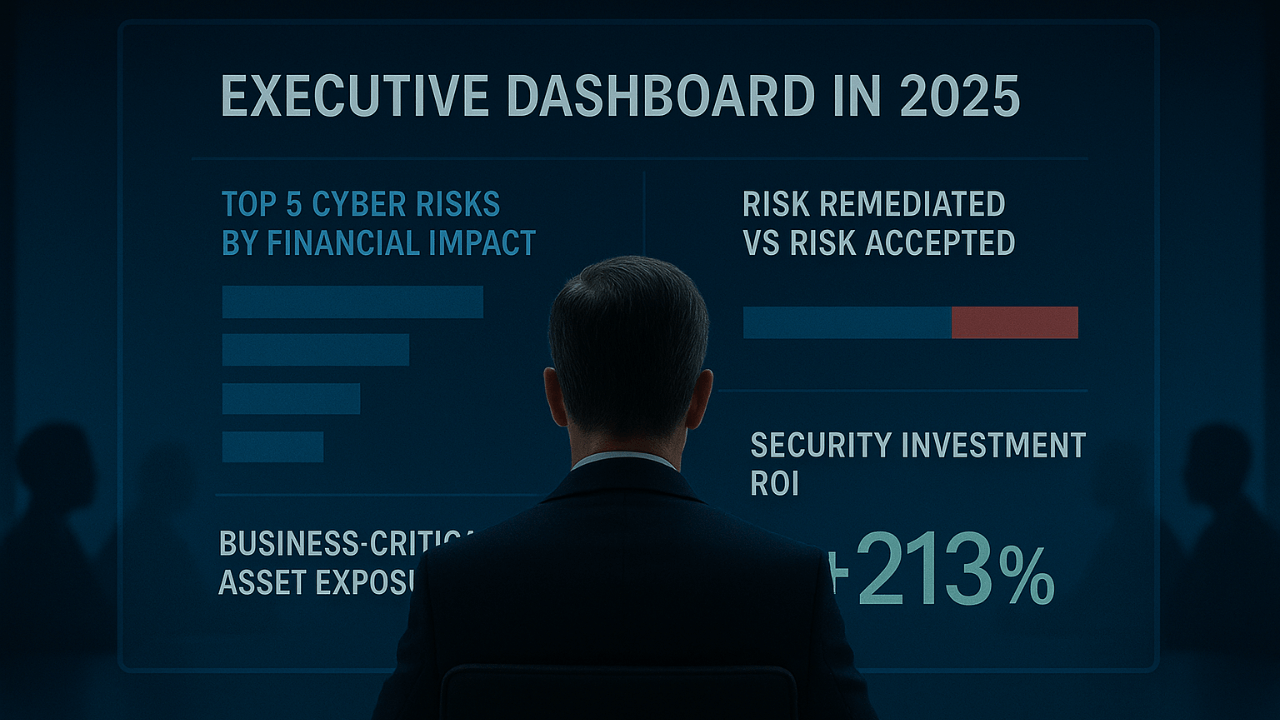

July 14, 2025
In boardrooms and executive suites across the globe, cybersecurity is no longer a “monthly update” topic — it’s a real-time risk and business decision layer. But despite millions spent on tools, SIEMs, and dashboards, most security leaders still struggle with a familiar pain: dashboards that impress but don’t influence.
The truth? Many dashboards are built for visibility, not action.
In 2025, that’s no longer enough. CISOs need dashboards that tell a story, align with financial priorities, and prompt decisions before the next exploit or audit cycle. Here’s how to shift from passive reporting to strategic orchestration.
Executives aren’t looking for alert volumes or patching SLAs in isolation. They want contextual answers to high-stakes questions:
Key metric shift: Replace volume-based metrics (e.g., number of vulnerabilities) with impact-weighted insights (e.g., % of high-value assets exposed to critical CVEs currently being exploited in the wild).
AI-powered risk quantification platforms like Balbix now make it possible to translate technical telemetry into financial exposure — in real time. This is no longer a luxury. It’s a CISO necessity.
To influence the board, CISOs must shift from volume-based indicators to value-based metrics that connect security to business outcomes. Here are the 7 metrics that belong on every modern security dashboard in 2025:
| Metric | Why it Matters to the Board |
| Top 10 Cyber Risks by Financial Exposure | Frames risk in dollars, not colors. Helps prioritize mitigation spending. |
| Risk Accepted Vs Risk Remediated | This shows how much cyber risk is being knowingly tolerated — a huge governance insight for Boards. |
| % of Business-Critical Assets Exposed to Active Threats | Highlights real risk to revenue-generating functions, not just generic systems. |
| Remediation Velocity for High-Risk Issues | Shows how fast the org is closing exposure on what matters most. |
| User Behavior Risk Index | Measures insider risk, shadow IT, and credential hygiene — increasingly vital in hybrid environments. |
| Security Investment ROI (e.g., risk delta pre/post controls) | Helps justify spending and prove effectiveness to CFO/CEO. |
| Regulatory & Compliance Exposure | Tracks readiness across frameworks (DORA, NIS2, SEC cyber rules), increasingly key for board review |
In 2025, generative AI is not just helping red and blue teams — it’s transforming the way CISOs communicate with executive stakeholders.
Use cases include:
Instead of relying on overworked analysts to translate technical data into business terms, AI now provides narrative intelligence — contextualizing telemetry in a language the CFO and CEO can act on.
Let’s be clear: good dashboards don’t just inform — they secure funding.
A security leader at a Fortune 100 manufacturer recently shared how a risk-based dashboard helped her win a $7M increase in cybersecurity investment. Why? Because her dashboard showed that a single business-critical app exposed to an unpatched vulnerability could result in $58M in projected downtime and regulatory loss — validated by real-time CRQ metrics.
Executives don’t fund “security.” They fund risk reduction and business continuity. The right dashboard frames cybersecurity as a business enabler, not an expense line.
To evolve your dashboards into strategic weapons, start here:
In 2025, cybersecurity leadership is no longer judged by how much telemetry you collect — but by how well you translate it into timely, trusted business decisions. Dashboards are your executive interface. Make them intelligent. Make them financial. Make them actionable.
Your boardroom will thank you.
Want to go deeper?
Explore how AI-powered CRQ and real-time risk storytelling can drive smarter decisions and secure budget in your organization.